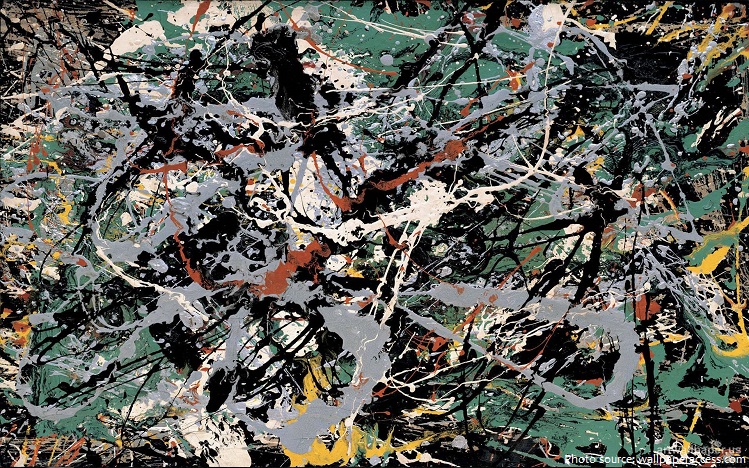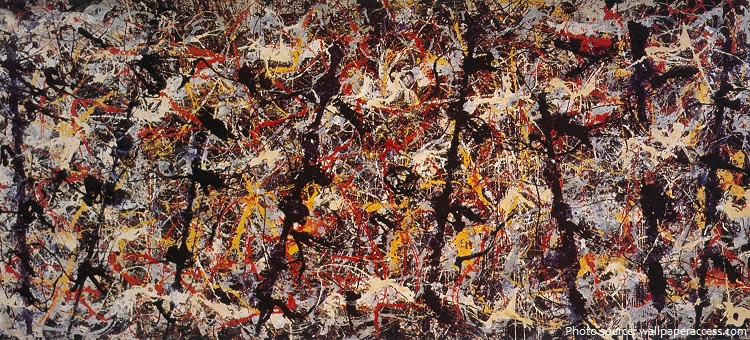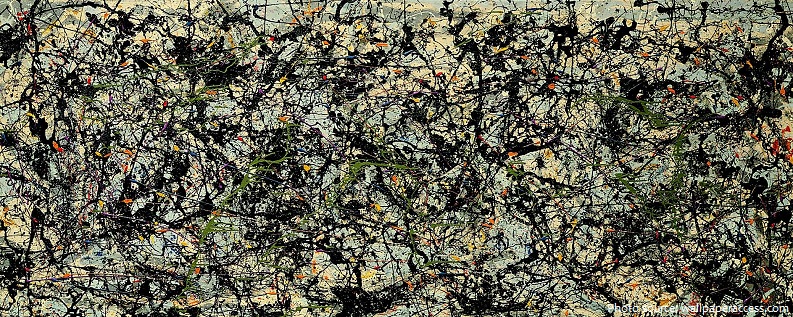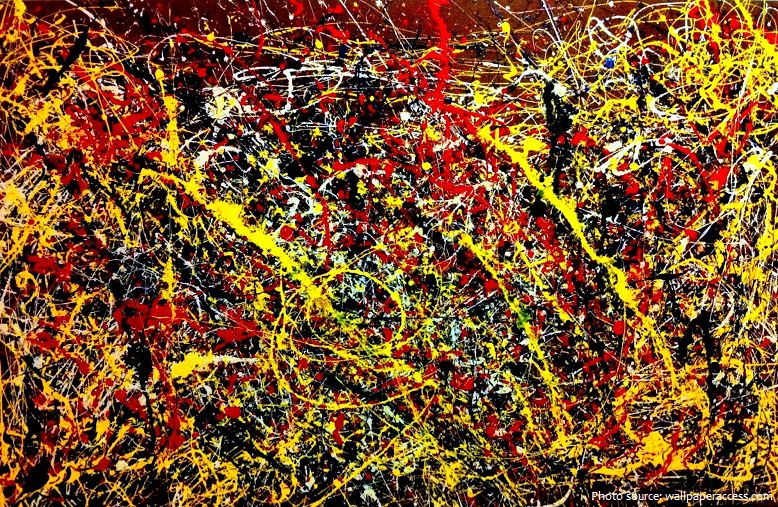
Paul Jackson Pollock was an American painter and a major figure in the abstract expressionist movement.
He was widely noticed for his “drip technique” of pouring or splashing liquid household paint onto a horizontal surface, enabling him to view and paint his canvases from all angles. It was also called all-over painting and action painting, since he covered the entire canvas and used the force of his whole body to paint, often in a frenetic dancing style.
He has become an icon of 20th century American art. Pollock’s “drip” paintings are immediately recognizable, and his hardscrabble life has fed into an enduring mythology of the modern artist as rebel.

The fifth and youngest son in a struggling farming family, Pollock was born in Cody, Wyoming, and grew up with his four brothers in Arizona and California. Although family resources were limited, his determined mother fostered artistic potential in each of her children (three became artists).
While living in the Vermont Square neighborhood of Los Angeles, he enrolled at Manual Arts High School, from which he was expelled. He had already been expelled in 1928 from another high school. During his early life, Pollock explored Native American culture while on surveying trips with his father. He was also heavily influenced by Mexican muralists, particularly José Clemente Orozco, whose fresco Prometheus he would later call “the greatest painting in North America”.
After being expelled from the Manual Arts High School, Jackson Pollock followed his older brother to New York City in 1930. He studied at the Art Students League with regionalist painter Thomas Hart Benton. Pollock explored Native American art, the works from Spanish surrealist artists like Pablo Picasso and Joan Miró, as well as Mexican muralists like José Clemente Orozco and David Alfaro Siqueiros.

Pollock was introduced to the use of liquid paint in 1936 at an experimental workshop in New York City by the Mexican muralist David Alfaro Siqueiros. He later used paint pouring as one of several techniques on canvases of the early 1940s, such as Male and Female and Composition with Pouring I. After his move to Springs, New York, he began painting with his canvases laid out on the studio floor and he developed what was later called his “drip” technique.
During the Depression, President Franklin D. Roosevelt started a program called the Public Works of Art Project, one of many intended to jumpstart the economy. Pollock and his brother Sanford, known as Sande, both found work with PWA’s mural division. The WPA program resulted in thousands of works of art by Pollock and contemporaries such as José Clemente Orozco, Willem de Kooning and Mark Rothko.
In 1939, Pollock began visiting a Jungian analyst to treat his alcoholism, and his analyst encouraged him to create drawings. These would later feed his paintings, and they shaped Pollock’s understanding of his pictures not only as outpourings of his own mind, but expressions that might stand for the terror of all modern humanity living in the shadow of nuclear war.

Pollock’s most famous paintings were made during the “drip period” between 1947 and 1950. He became famous following an August 8, 1949, four-page spread in Life magazine that asked, “Is he the greatest living painter in the United States?” Thanks to the mediation of Alfonso Ossorio, a close friend of Pollock, and the art historian Michel Tapié, the young gallery owner Paul Facchetti, from March 7, 1952, managed to realize the first exhibition of Pollock’s works from 1948 to 1951 in his Studio Paul Facchetti in Paris and in Europe.
He later returned to using color and continued with figurative elements. During this period, Pollock had moved to the Sidney Janis Gallery, a more commercial gallery – the demand for his work from collectors was great. In response to this pressure, along with personal frustration, his alcoholism deepened.
In December 1956, Pollock was given a memorial retrospective exhibition at the Museum of Modern Art in New York City, and then another in 1967. His work has continued to be honored on a large scale, with frequent exhibitions at both the MoMA in New York and the Tate in London. He remains one of the most influential artists of the 20th century.

In 1973, Number 11, 1952 (also known as Blue Poles) was purchased by the Australian Whitlam government for the National Gallery of Australia for US$2 million (A$1.3 million at the time of payment). At the time, this was the highest price ever paid for a modern painting. The painting is now one of the most popular exhibits in the gallery. It was a centerpiece of the Museum of Modern Art’s 1998 retrospective in New York, the first time the painting had been shown in America since its purchase.
In November 2006, Pollock’s No. 5, 1948 became the world’s most expensive painting, when it was sold privately to an undisclosed buyer for the sum of US$140 million. Another artist record was established in 2004, when No. 12 (1949), a medium-sized drip painting that had been shown in the United States Pavilion at the 1950 Venice Biennale, fetched US$11.7 million at Christie’s, New York. In 2012, Number 28, 1951, one of the artist’s combinations of drip and brushwork in shades of silvery gray with red, yellow, and shots of blue and white, also sold at Christie’s, New York, for US$20.5 million—US$23 million with fees—within its estimated range of US$20 million to US$30 million.